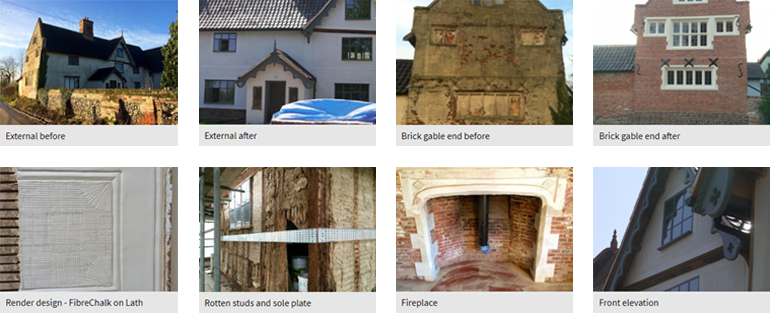Home Farm in Suffolk restored to former glory
Home Farmhouse in north-west Suffolk is a two storey timber and attic framed house. The original part of the house dates to 1325 and can be attributed to a St Cross family called Collebells. Indeed Collebells was the original name of the house and only became Home Farm 200 years later. Originally a high-status Yeomans’ house it gradually expanded and became a large dairy farm sometime in the 16th century.
After being badly maintained for 30 or so years, it was purchased by the current owners at auction five years ago. They were well aware of the extent of the work that was required and vowed to work towards restoring it to its former glory. Consequently in December 2013 restoration specialist, Mike Frost (Oak & Lime) Ltd first set his eyes on the place. His first job? To shoot the rats and cover it in tarpaulin! Work started in earnest the following spring and, two and half years and thousands of hours of work later it is nearing completion.
To give an idea as to the extent of the project, bar just 1.2 metres, the entire sole plate required replacing, all the brick plinths were re-built, the brick gable end was in need of total restoration and the remaining elevations required complete re-rendering. Internally there have been layers and layers of paint and old Limewash removed, lath replacement, insulation replacement, restoration of plasterwork, and the restoration of three fireplaces. All of which has been carried out with painstaking attention to detail including careful consideration of which materials to use. Each job within the project required materials that would replicate what would have originally been used whilst giving the building what it needs to ensure it will stand strong for another few hundred years.
Throughout the property, internally and externally, ancient Limewash was meticulously cleaned using Aciclean and layers of old paint and varnish was removed with Kling-Strip – both reliably effective products from Strippers Paint Removers. On some areas there were 17 layers of paint hiding beautiful old timber.
The now striking brick gable end was in a bad way. Damage caused by well-intended yet inappropriate repairs using cementitious mortars had resulted in damp and fungal spores, which had turned the three sets of lintels to powder. To restore it, careful consideration had to be given to the soft red brick substrate. Anglia Lime Company (ACL) formulated a DryReadymix mortar that would not only give the right aesthetics but provide the right mechanical requirements for the 16th Century soft red bricks. The re-pointing was then copied from an original section found in still perfect condition in the double-struck/birds-beak style.
The dramatic mullion windows were reconstructed using special bricks before being rendered in a replication of an Elizabethan mix of ALC’s very fatty lime putty and glacial sand.
The other elevations were re-rendered using a fibre/hair, chalk, putty mix made by ALC to Mike’s specifications. It was finished with a pattern found on an original piece of plaster called sparrow-peck. It is believed the origin of this pattern is from weaving or hurdle making. Considering the house stands on the northern tip of what was once the largest bit of grazing ground in the area this is highly plausible.
And that’s just the outside story! Very shortly work will be completed and the finely restored Collebells will stand proud once more.

For further information visit www.anglialime.com















